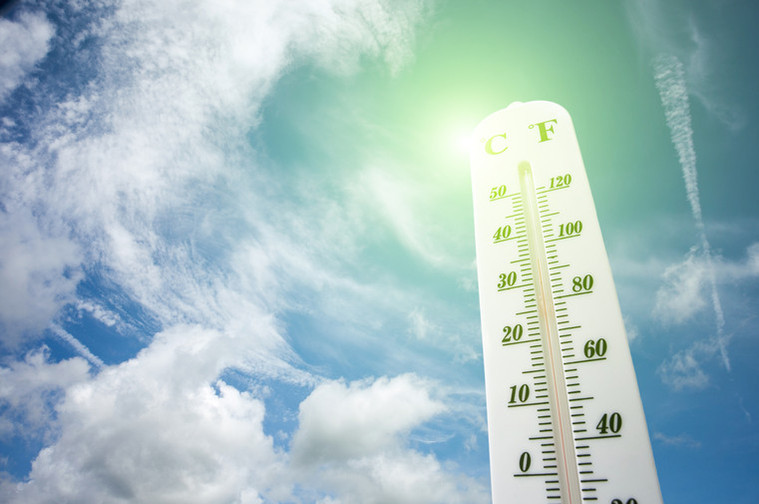An agricultural expert is warning about the potentially fatal impact of heat stress on livestock and outlined steps farmers can take to reduce the risk, after the Met Office issued its first ever extreme heat warning.
The amber warning covers large parts of Wales, all of south-west England and parts of southern and central England and will be in place until Thursday, when temperatures are expected to peak.
The Met Office launched its new extreme heat warning in June 2021 to highlight potential widespread disruption and adverse health effects.
The warning came after all four UK nations recorded the hottest day of the year over the weekend.
Rob Matthews, of rural insurance broker Lycetts, urged farms – particularly mixed farms – to not overlook the effect of rising temperatures on livestock and to take precautionary measures against heat stress.
He said: “Farming is a weather dependent industry, acutely sensitive to temperature extremes, so the summer can be an extremely worrying and testing time of year for farmers, particularly as the weather increasingly oscillates between heavy rainfall and soaring temperatures due to climate change.
“Harvest often takes precedence in these critical months, with time and effort concentrated on maximising yields.
“Of course, the wellbeing of the livestock is also top priority for farmers, but it takes just a few extra degrees, over a relatively short period of time, for animals to suffer the effects of heat stress – it can happen quickly and without much warning.
“Unfortunately, many animals do not have the ability to dissipate enough heat to maintain homeothermy, so even seemingly subtle increases in air temperature can be very harmful and can lead to death.
“An increase in body temperature can also impact on milk productivity in dairy cows, and cause beef cattle to lose condition.
“Farmers care deeply about the wellbeing of their animals and losing animals in this way can be very distressing.”
Rob outlined some simple measures farmers can take to reduce the risk of heat stress in different farm animals.
Beef cattle
Cows out to pasture are not usually as susceptible to heat stress as those kept in sheds.
Cattle naturally produce a lot of heat whilst they’re eating, and this peaks around four hours after feeding. Therefore, cattle kept in sheds need to be fed earlier than usual to avoid their body temperatures peaking in the middle of the day.
Dairy cattle
Increased ventilation, fans, shade and sprinklers can all help with reducing body temperatures. These should be used in holding pens and milking parlours.
Access to water should be a given but intake is likely to double under heat stress. Make sure calves in huts or cows separated for rest have additional water, as these animals are more susceptible to heat stress.
An increase in moisture caused by excessive sweating can also lead to mastitis.
Pigs
Pigs are much more sensitive to heat than other animals because they lack the ability to sweat.
Signs of stress in pigs include open-mouth breathing, vocalisation, blotchy skin, stiffness, muscle tremors and reluctance to move. If pigs begin to demonstrate these symptoms, allow them to rest, keep them cool with fans and have access to plenty of water.
It can be helpful to sprinkle cool water onto pigs. Avoid pouring large amounts of cold water onto the pigs, as this could cause shock.
Pigs housed outside need plenty of shade.
Sheep
Sheep tend to be less susceptible to heat stress than other livestock. Wool protects sheep from extreme heat, as well as extreme cold.
Make sure sheep have been sheared and pay close attention for issues caused by flies.
During periods of extended heat and humidity, it may be necessary to provide extra water.
Poultry
Poultry are highly susceptible to heat stress, and the first sign of this in birds is panting.
To prevent overheating, keep sheds well ventilated, look to decrease the number of birds per square metre and keep water sources fresh and cool.
Birds produce heat whilst digesting food so look to feed birds during the cooler parts of the day. With broilers and turkeys remove feed from the birds around six hours before peak temperatures and reintroduce once it’s starting to cool.
Working dogs
Don’t forget about working dogs during extreme heat.
Avoid working them during the peak of the day. Keep dogs in well ventilated shade and with regular access to water. A shallow paddling pool is a fast way for a dog to cool down their body temperature.
Avoid taking dogs with you in the tractor or pick-up whilst temperatures are high.
“General advice would be to monitor heat levels, take measures to keep animals cool when temperatures start to rise, and look out for tell-tale signs, such lethargy, open-mouth panting, reduced food intake and agitation,” added Rob.
“Farmers should also remember that they are not immune to heat stress themselves. Remember to seek shade, particularly at the hottest times of the day, drink plenty of water, and take regular rest periods.”
If animals are displaying signs of heat stress, farmers are advised to seek veterinary help immediately.




